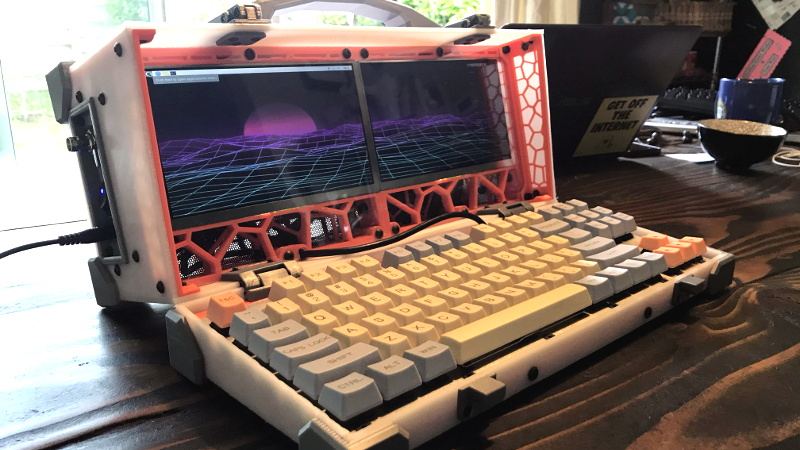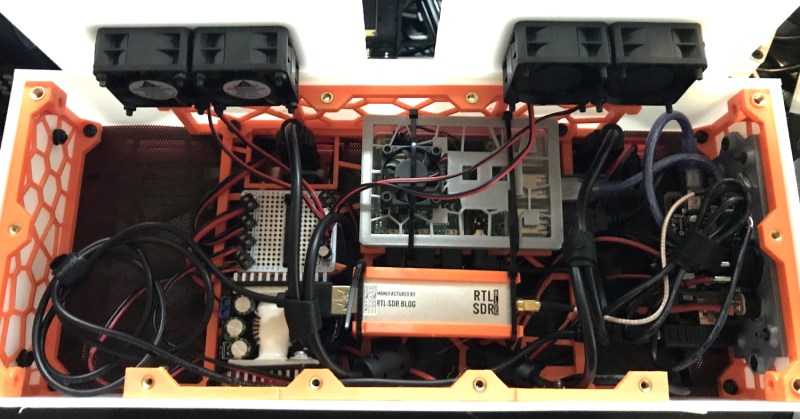It’s been fascinating to watch the development of bespoke mobile computers go from a few sheets of foam board and a Raspberry Pi into hardware that looks like it’s actually been transported here from an alternate reality. Granted a Raspberry Pi is more often than not still onboard, but the overall design and construction techniques of these very personal computers has improved by leaps and bounds.
The latest of these cyberdecks, a dual screen “luggable” reminiscent of classic computers like the Compaq Portable or Kaypro, comes our way from [dapperrogue]. Powered by the Raspberry Pi 4 and featuring a scratch-built mechanical keyboard to perfectly fit the machines’s specific dimensions, this is easily one of the more practical builds we’ve seen. As visually striking as they may be, few would argue that the small offset display that seems characteristic of most decks are ideal from a usability standpoint.
While the keyboard plate was milled out on a CNC, [dapperrogue] says the design of the HDPE body panels and rear polycarbonate viewing window were simple enough they could be done by hand on a band saw. The PETG internal frame uses a Voronoi pattern that not only reduces the amount of time and material required to print it, but maximizes airflow. The fact that it looks like some kind of alien biological life form only helps the retro-futuristic aesthetics.
There’s still plenty of room inside the enclosure, which is good, as [dapperrogue] says there’s more goodies to come. Adding internal battery power is a logical next step, and now that the Pi 4 can boot to external drives, and SSD is also on the list of future upgrades.
For readers who might be getting a sense of déjà vu from this project, [dapperrogue] notes this design was inspired by the phenomenal Reviiser that [Dave Estes] released earlier this year.

















Looking really nice
Compared to the weight of the real luggables, this is a big improvement.
They could add some breaks inside the case to add a sense of authentic weight.
Bricks would probably be better… :P
Sorry about that, I missed it by that much.
Was thinking the voronoi pattern was for shock absorption, then noticed it was for airflow.. maybe print it in flexible filament next time so it does both!
Almost any filament is flexible if you try hard enough… but not too hard ;D
Indeed, I’d think that thickness is just about right in PLA/ABS type stiffness range. Not so thick it won’t take some shock out but more than stiff enough to hold everything in its place. Not 100% sure how its all assembled as to if anything is ‘shock’ mounted, if not would be a good improvement as you will drop it at some point.
I i were him i’d throw a HackRF One clone in there from AliExpress for $60 and a WiFi Pineapple too and what aboutthe GSM modem. this thing is still raw in the middle, plenty of space is going to waste in that cyberdeck.
I love where you are going with this
Really nice work!
“alien” biological life form ? Ask for onions on your pizza, Tom!
The new Ono-Sendai deck is looking great.
At first glance I thought he just stuck a Model M space saver in there. Guess the F keys are a lot different, it was the PU/PD etc cluster and arrow key placement I think.
https://en.wikipedia.org/wiki/Model_M_keyboard#/media/File:Blake_Patterson_IBM_Model_M_Keyboard_space_saver_1.jpg
Takes some real dedication but he wired up his own mechanical keyboard just for this build. I’m super impressed.
Its cool to wire your own up, and if you need features older keyboards don’t have (like 100% anti-ghosting) or really need to keep it compact its necessary. But if you can use a model M or any other decent mechanical in your build it might well be the ‘best’ way. Not only are the good mechanicals popular enough that replacement parts are usually available but most of them also already come with a good degree of stiffness which leads to good typing feel.
That said any excuse to have some fun with your design is work taking if you have time!
The kids these days seem to think that EMF means “Electro Magnetic Field”, rather than “Electo Motive Force”. So they probably have no idea what EMI or RFI mean.
I really like this build. For my own purposes I’d want my cyberdeck to be less chunky, but there are so many elements of this that I’m inspired by.
To this build I think I’d add a parts drawer or something (eg for an antenna and power supply). It should be really good when it’s able to be battery powered.
2 points for HDPE body panels.
1 point for PETG if it a high temperature(100C) one, but -2 point if it a typical one which start deform at 65-70C.
Looks nice, but, no EMF protection/abatement whatsoever?
What exactly did you have in mind? Remember that EMF is in fact necessary for powering the device.
“It’s not a lunchbox, it’s a CYBERdeck”
“Where do you put the thermos?”
Wow, that one is a real beaut!